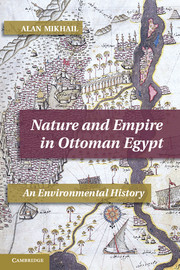Book contents
- Frontmatter
- Contents
- Maps
- Figures
- Tables
- Note on Transliteration and Dates
- Abbreviations
- Acknowledgments
- Map 1 Egypt and the Ottoman Empire
- Map 2 Lower Egypt (Nile Delta)
- Map 3 Middle Egypt
- Map 4 Upper Egypt
- Map 5 Cairo and Surroundings, 1801
- Introduction: Empire by Nature
- 1 Watering the Earth
- 2 The Food Chain
- 3 The Framework of Empire
- 4 In Working Order
- 5 From Nature to Disease
- 6 Another Nile
- Conclusion: The Imagination and Reality of Public Works
- Appendix: Citations for Cases Included in Tables 2.1–2.4
- Bibliography
- Index
- Titles in the series
6 - Another Nile
Published online by Cambridge University Press: 03 May 2011
- Frontmatter
- Contents
- Maps
- Figures
- Tables
- Note on Transliteration and Dates
- Abbreviations
- Acknowledgments
- Map 1 Egypt and the Ottoman Empire
- Map 2 Lower Egypt (Nile Delta)
- Map 3 Middle Egypt
- Map 4 Upper Egypt
- Map 5 Cairo and Surroundings, 1801
- Introduction: Empire by Nature
- 1 Watering the Earth
- 2 The Food Chain
- 3 The Framework of Empire
- 4 In Working Order
- 5 From Nature to Disease
- 6 Another Nile
- Conclusion: The Imagination and Reality of Public Works
- Appendix: Citations for Cases Included in Tables 2.1–2.4
- Bibliography
- Index
- Titles in the series
Summary
As we have seen in the preceding two chapters, various sets of transformations over the course of the long eighteenth century served to shape the rough outlines of a new conception of society in Egypt as the province moved further and further away from its previous centrality in the Ottoman system of imperial natural resource management. Changes in the organization of labor formed the bases for ideas of an Egyptian population – its size, potentials, and resources. The advent of quarantine to address plague in Egypt not only represented a different conception of the place of disease in the environment but also served to define the physical realm of the social as opposed to that of the diseased and dying. This chapter returns us more squarely to irrigation works to examine how several of these new processes, ideas, and institutional formations came to bear on the development of a new imaginary of what Egypt was and into what it could be fashioned. The event around which these processes and ideas coalesced was the reconstruction of the Maḥmūdiyya Canal in the second decade of the nineteenth century.
The project of rebuilding what would come to be known as the Maḥmūdiyya Canal was one meant to serve the society defined by technologies such as quarantine. It was a canal that would feed water to Alexandria, thus making the city a thriving economic and cultural metropolis to rival Cairo.
- Type
- Chapter
- Information
- Nature and Empire in Ottoman EgyptAn Environmental History, pp. 242 - 290Publisher: Cambridge University PressPrint publication year: 2011

